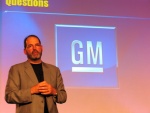GM, through its first two generations of outsourcing, has achieved over $1 billion annual savings through consolidation and systems reduction. We are now crafting our third generation outsourcing model. $15 billion.
|
Tony Scott of GM discusses GM's outsourcing and digital identity strategies.
|
GM has a "legacy of many." We were the poster child for slow, inefficient, and costly. All that has changed. The evolution of IT in a company like GM is reminiscent of the Winchester Mystery House. The problem wasn't lack of architects and craftsmen, the problem was that Sarah Winchester lacked a plan. GM's identity infrastructure used to be the Winchester Mystery House of identity.
GM's first outsourcing effort happened when GM bought EDS. EDS essentially became GM's outsourced IT department. The was a very decentralized control of spending, no common identity system, no corporate governance. Cost was viewed by managers as "funny money." At the end of that period, GM had the highest IT costs as a percent of revenue of any car manufacturer.
In 1996, GM spun EDS out and a new IT management team was brought in. GM signed a 10 year master services agreement. GM spend about $4 billion/year with EDS in 1996, but now spends only $3 billion/year. Now GM is the lowest cost of it as a percentage of sales among car manufacturers. EDS doesn't have an exclusive contract enabling limited competitive sourcing. Governance was put in place.
In 2006, GM will open all their IT to the competitive market. GM's IT people currently manage 10,000 of contracts. The new model will reduce that number to a few dozens with hierarchical, prime contractor- subcontractor relationships. GM will have a global enterprise architecture and governance for identity allowing decentralized deployment and operation.
GM is so large that a system that is not federatable is unmanageable. It would be impossible to manage a centralized scheme for identity in this company. In the new model, GM will control access on an application by application basis and even a function by function basis rather than through a firewall.
An interesting addition in the new model: GM will require intellectual property indemnification from its contractors. This will flow through to subcontractors and suppliers. The industry is not set up to do this today.
Customs and traditions that people have in a particular country are an issue for a global company like GM. What identity means and how people feel about it affect relations with employees and customers alike.
GM does product development in dozens of countries. GM can now rollout an update to their iMan platform (digital product design suite) over a weekend due to common infrastructures. GM's product development used to take 5 years from concept to manufacturing. Now it takes 18 months. GM's new J-200 vehicle is engineered in 1 country, manufactured in 9 countries under 5 different nameplates and sold in 124.
Digital identity is the key. Required features: individual identity, permissions by application and by program, collaboration vs. protection tradeoffs, and common interoperable schemes for joint ventures, suppliers, and dealers. Identity is more than just people, its things as well. Parts of a car have identities.
Shifting focus to products. In 1970 a car had about 100,000 lines of code. In 1990, cars had 1,000,000 lines of code. In 2010, a typical vehicle will have 100,000,000 lines of code. Software and electronics now represent one-third of the cost of the vehicle. That's the largest single item.
OnStar is on its sixth generation in about seven years. That's unheard of in the automobile business. The software changes much faster than the vehicle its on. Cars hang around for tens of years. Software put into vehicles has to be supported for that period.
More than ever, people are clamoring for a seamless experience and that includes their vehicles. They want to integrate cell phones, MP3 players, and video devices with their cars.





